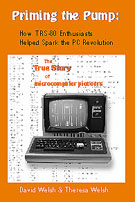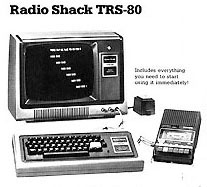Priming the Pump:
How TRS-80 Enthusiasts Helped Spark
the PC Revolution
-- From Chapter Three:
David’s Story

Priming the Pump: |
 |
 |
“Why use the Z80 microprocessor? Because it beats the others hands down.” It went on in that vein, but if you waded through the technical description, it was clear that this computer would come with a tiny BASIC ROM and 4K of memory and it included a monitor for about the cost of the original bare bones Altair. I didn’t know why it was important that the computer was going to use “dynamic” rather the “static” memory, but the whole package sounded like what I was waiting for. Four thousands bytes of RAM was considered a lot to come with the computer then, but eventually I’d have a wristwatch with more memory than that. A few months later, actual examples of the computer began appearing in local Radio Shacks. The TRS-80 looked cheap, but it was a good kind of cheap… a Model T kind of cheap. Besides, compared to the Altair, it looked like a well-designed consumer product. The Apple II and the Commodore PET were available by then, I think, but the PET had this tiny keyboard and the Apple used a TV set as a monitor and was way more expensive when you added up the cost of the add-ons you needed. The TRS-80 was close by. When you walked into a Radio Shack, there it was displaying the “Ready” prompt. What it was ready to do was have you type in a Level I BASIC program. The machine fascinated me. David Lien’s excellent manual was usually sitting beside the machine. There were almost no programs. It came with Backgammon and Blackjack. That was the “bundle.” If you wanted the computer to do anything else, you had to program it. In a very short time, the computers in the store were running short programs that some customer or store employee had typed into the computer and saved on cassette. I played a gun game where you used the arrow keys to raise or lower a gun and then the spacebar to shoot at the only other thing on the screen... another gun. A second player could then try to shoot back, but most times, I was also the second player. If you were curious about programming, you could press the BREAK key, which would stop the program, and then you could type “LIST.” This command would print the program on the screen. If the program was longer than 16 lines, it would scroll until it reached the end. BASIC programs have sequential line numbers, so if you wanted to see only the first part of the program you might type LIST 10-100 to show only the lines from 10 to 100. The command CLS was also handy because it would cause the screen to clear as would pressing the “CLEAR” key. Computers were not common back then so just watching it print programs on the screen was fascinating. By looking at these programs and trying the modify them, and by writing little
programs yourself, you could learn to program in BASIC. Radio Shacks were everywhere.
When one store became too crowded or its management looked like it was about to
run out of patience with you, it was off to another store.
|
 Read More Excerpts from Priming the Pump.
Read More Excerpts from Priming the Pump.
 Return to the Home Page for Priming the Pump.
Return to the Home Page for Priming the Pump.
 Go to the Order Form to buy Priming the Pump.
Go to the Order Form to buy Priming the Pump.